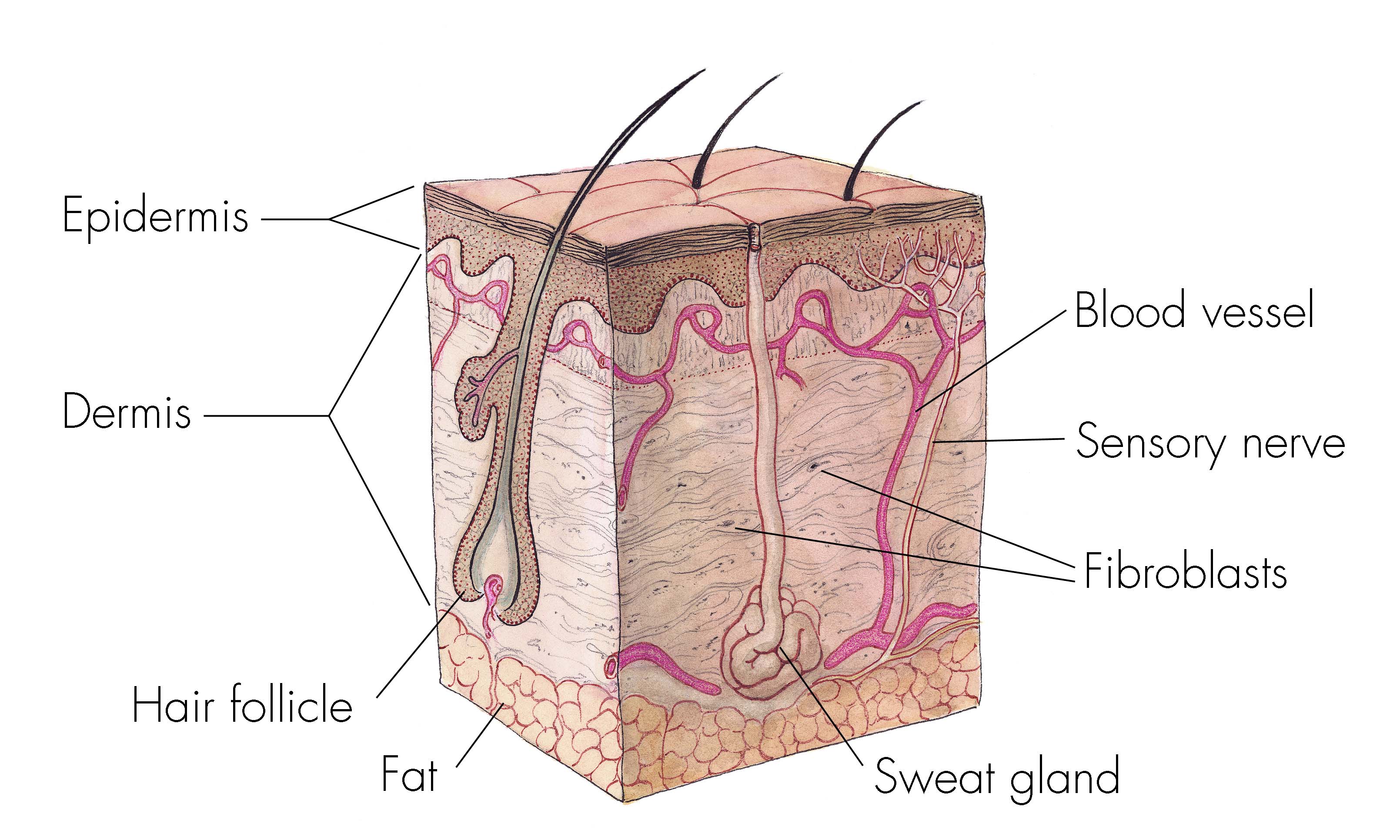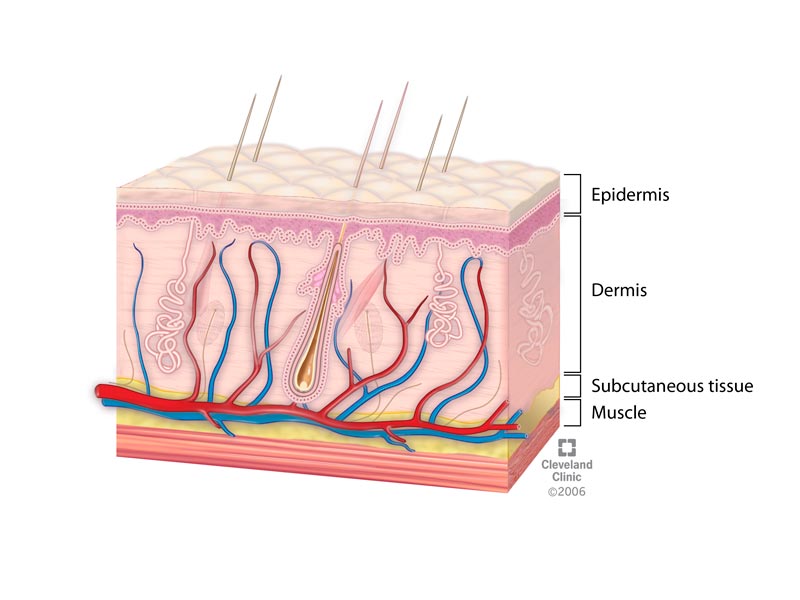Which of the Following Gives Rise to the Skin Cells
Each germ layer gives rise to specific tissue types. It also gives rise to that handsome one with the smoothly shaved face devastating eyebrows and mysterious eyes.

How Does The Outer Layer Of Skin Cells On My Finger Detect When I Am Touching An Object Science Questions With Surprising Answers
As a result these cells will differentiate into epidermal cells.

. Our skin is a major organ derived from our ectoderm. Certain cells in the innermost layer of the skin or epidermis called the basal layer can sometimes give rise to cancer particularly when theyve been damaged by excessive exposure to UV. The three germ layers are the ectoderm mesoderm and endoderm.
B antibody present on the white blood cells. The ectoderm is one of the primary layers of cells that exists in an embryo. Langerhans cells activate the immune system.
Asked Mar 14 2016 in Psychology by La_Bamba. The remaining cells in the center form the neural plate. Tactile cells anchor the skin to the body.
All of the above FeedbackThe mesoderm gives rise to all types of muscle tissue tubule cells of the kidney and red blood cells. The mesoderm gives rise to the connective tissues and cells of the. For example some cells in the ectoderm will express the genes specific to skin cells.
In addition the ectoderm forms the external surfaces of the eyes cornea and lens teeth enamel mouth and rectum as well as. Melanin provides protection against ultraviolet UV radiation. Primarily composed of adipocytes arrector pili muscle smooth muscle that gives you goose bumps sebaceous gland associated with hair follicles hair follicle cells that surround and give rise to hair sudoriferous sweat gland coiled gland sometimes associated with hair follicles but not always epidermis layer of skin dermis.
As stem cells of the stratum basale divide they give rise to keratinocytes that migrate toward the skin surface and replace lost epidermal cells. The mesoderm gives rise to the connective tissues and cells of the. C antigen present on the red blood cells.
The endoderm gives rise to the gut and other internal organs and not to the skin. In the development of embryonic skin the _____ layer gives rise to the epidermis and the _____ gives rise to the dermis layer of cells covering the developing embryonic epithelium periderm. To learn more about the layers of our epidermis skin check out our quick and easy video on skin mnemonics above.
The skin consists of two main regions. Intermediate filaments made of keratin extend from desmosome on one side of the cell to desmosomes on the opposite end of the cell. The ectoderm cells differentiate into cells that form a number of external structures such as skin sweat glands skin sensor receptors and hair follicles.
Question 48 of 50 00 20 Points The embryonic tissue level mesoderm gives rise to which of the following types of tissue. D antigen present on the white blood cells. The ectoderm forms epithelial cells and tissues and neuronal tissues.
Step 1 of 5. Cells derived from the mesoderm which lies between the endoderm and the ectoderm give rise to all other tissues of the body including the dermis of the skin the heart the muscle system the urogenital system the bones and the bone marrow and therefore the blood. Hypodermis not technically a layer of the skin.
The process of differentiation is regulated by cellular signaling cascades. All cells reproduce by splitting into two where each parental cell gives rise to two daughter cells. Which of the following gives rise to the skin cells.
Which of the following gives rise to the skin cells. In most skin this is the thickest stratum but in the thick skin it is usually exceeded by the stratum corneum. Antibody present on the red blood cells.
Organogenesis is the formation of organs from the germ layers. These newly formed daughter cells could themselves divide and grow giving rise to a new cell population that is formed by the division and growth of a single parental cell and its descendant. This gives tensile strength to cells and tissues.
Common among epidermis and cardiac cells. Gastrulation is the process by which cells of the blastula get rearranged in order to form three cell layers which are known as the germ layers. The word Exeter comes from the Greek Actos which means outside or outer and derma meaning skin so acted ERM being the external layer and it gives rise to.
Each of these three components will give rise to a particular compliment of cells. Add to Existing Playlist. A ectoderm B endoderm C mesoderm D none of the above.
Keratinocytes produce a fibrous protein to protect the epidermis. The word Exeter comes from the Greek Actos which means outside or outer and derma meaning skin so acted ERM being the external layer and it gives rise to the epidermis which obviously is your skin cells. None of the above.
The outer layer of the cell mass during the embryonic stage which gives rise to the nervous system sensory receptors and outer skin layers is called the. The layer that gives rise to our skin is known as the ectodermal layer. Your email address will not be published.
The endoderm gives rise to the gut and other internal organs and not to the skin. The neural tube cells give rise to the central nervous system neural crest cells give rise to the peripheral and enteric nervous system melanocytes and facial cartilage and the epidermal region will give rise to the epidermis hair nails sebaceous glands. During the formation of the neural system special signaling molecules called growth factors signal some cells at the edge of the ectoderm to become epidermis cells.
Gastrulation is the process by which cells of the blastula get rearranged in order to form three cell layers which are known as the germ layers. Step 1 of 4. The ectoderm gives rise to the nervous system and the epidermal skin cells the mesoderm gives rise to the muscle cells and connective tissue in the body and the endoderm gives rise to the digestive system and other internal organs.
Leave a Reply Cancel reply. The three germ layers are the ectoderm mesoderm and endoderm. Tactile cells anchor the skin to the body.
The layer that gives rise to our skin is known as the ectodermal layer. The mesoderm is the germ layer that distinguishes evolutionarily higher. The cadherins extend into the intercellular space between adjacent membranes and attach cells to one another.
Science Anatomy and Physiology QA Library Which of the following gives rise to the skin cells. During differentiation the embryonic stem cells express a specific set of genes that will determine their ultimate fate as a cell type. Which of the following structures in the skin give rise to fingerprints.
The stratum spinosum spy-NO-sum consists of several layers of keratinocytes.


No comments for "Which of the Following Gives Rise to the Skin Cells"
Post a Comment